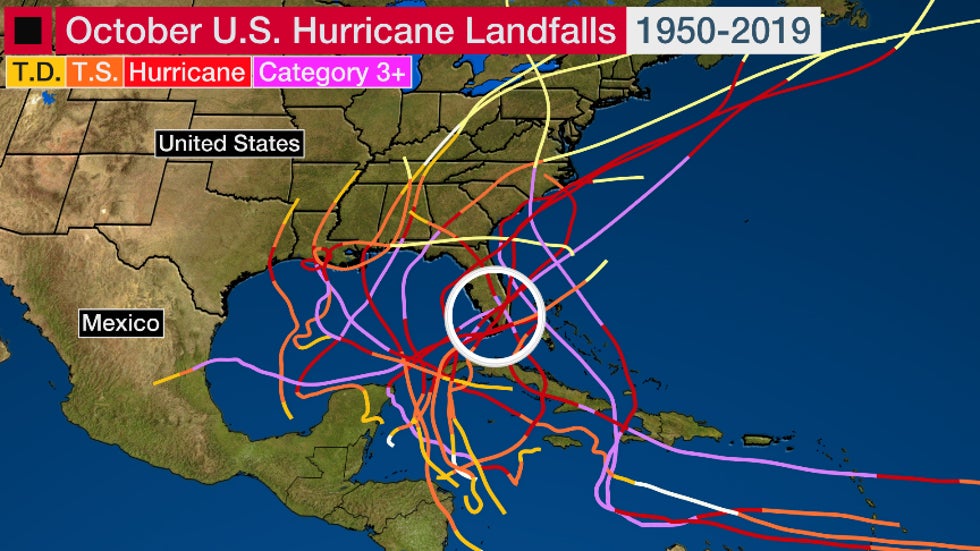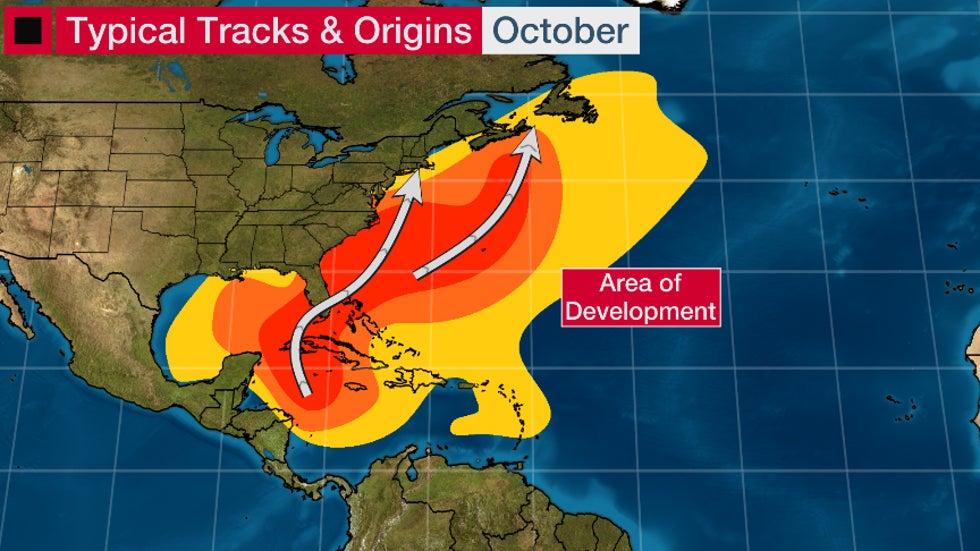Linda Lam and Chris Dolce
The threat of Atlantic hurricanes remains high in October, as residents of both the Southeast and Gulf Coast have been reminded of in recent years.
Florida is the state most likely to see a landfalling hurricane in October, with the southern part of the state most at risk.
From 1851 to 2019, 33 hurricanes made a Florida landfall in October, dwarfing Louisiana, the state with the second-highest number of October landfalls, with 10.
There have been 18 major hurricanes (Category 3 or higher on the Saffir-Simpson Hurricane Wind Scale) that have made direct hits on the U.S. mainland in the month of October since 1851. Florida was struck by 11 of those.
It becomes more difficult for hurricanes to make landfall farther north in October as the upper-level wind pattern changes and the jet stream slides farther south, but Superstorm Sandy broke many meteorological rules of thumb when it hit the Northeast in 2012.
The map below shows the 16 hurricanes that have made a U.S. landfall in October since 1950, not including Sandy since it did not officially make landfall as a hurricane. Nine of those occurred in Florida, and the majority of them affected the southern half of the peninsula.
 Track of hurricanes that have made landfall in the U.S. in October from 1950-2017.
Track of hurricanes that have made landfall in the U.S. in October from 1950-2017.Since 2016, hurricanes Matthew, Nate and Michael all made a U.S. landfall in the first half of October. The U.S. was spared from any late-season hurricane strikes last year.
Matthew and Michael had the most devastating impacts of the three most recent October hurricanes to strike the U.S.
Hurricane Matthew made one official U.S. landfall Oct. 8, 2016, to the southeast of McClellanville, South Carolina, as a Category 1 hurricane with 75-mph winds. Matthew's rainfall was its legacy in the Carolinas, where it produced serious flooding.
Before the South Carolina landfall, Matthew paralleled the coasts of Florida and Georgia, bringing wind gusts as high as 107 mph to Cape Canaveral, Florida, and a peak storm surge of 9.88 feet above normal at a National Ocean Service tide gauge at Fernandina Beach, Florida.
Hurricane Michael made an extremely rare Category 5 U.S. landfall in the Florida Panhandle on Oct. 10, 2018.
Storm surge from Michael produced catastrophic damage in Mexico Beach, Florida. Wind damage was extreme along its path from the Florida Panhandle all the way into southern parts of Georgia.
Late-Season Typical Development Areas and Tracks
Even though the climatological peak of the hurricane season – Sept. 10 – has passed, residents along the Gulf and East coasts need to remain prepared for a hurricane. Roughly one-fifth of all U.S. hurricane landfalls have occurred in October and November.
On average, one hurricane forms every year in October, according to the National Hurricane Center. The most hurricanes to form in October was five in 2010.

By October, the formation zones of tropical storms and hurricanes shift westward toward the western Caribbean Sea, eastern Gulf of Mexico and far western Atlantic Ocean as the "Cabo Verde" portion of the hurricane season, featuring the development of African easterly waves in the eastern Atlantic Ocean, fades.
In South Florida, October is the month with the most hurricane direct hits. Just over two dozen October hurricanes have passed within 100 nautical miles of downtown Miami since 1851, according to NOAA's best track database.
Hurricane season quiets down as we head into November, especially for the United States.
There are just three known U.S. hurricane landfalls in the month of November dating to 1861.
Hurricane Kate in 1985 was the latest-in-season hurricane landfall in the U.S. Kate came ashore at Mexico Beach, Florida, on Nov. 21, a week before Thanksgiving.
The Weather Company’s primary journalistic mission is to report on breaking weather news, the environment and the importance of science to our lives. This story does not necessarily represent the position of our parent company, IBM.
The Weather Company’s primary journalistic mission is to report on breaking weather news, the environment and the importance of science to our lives. This story does not necessarily represent the position of our parent company, IBM.

No comments:
Post a Comment